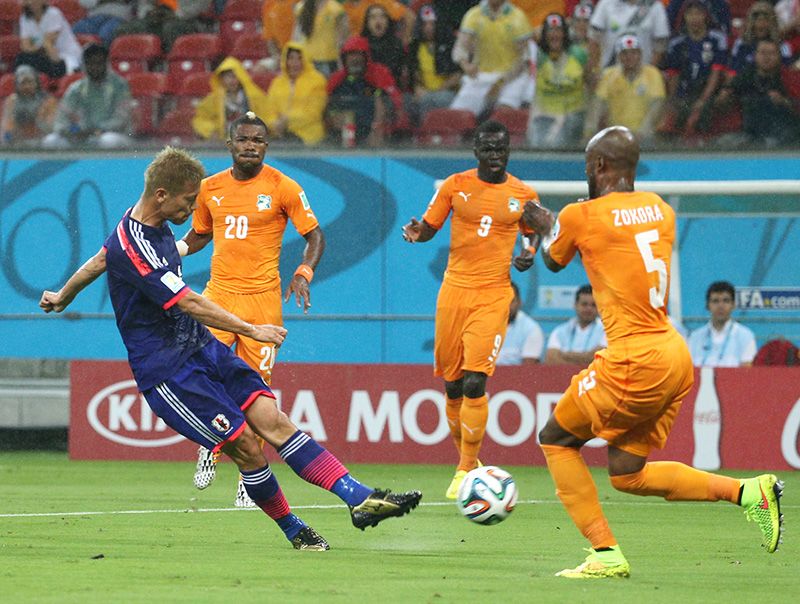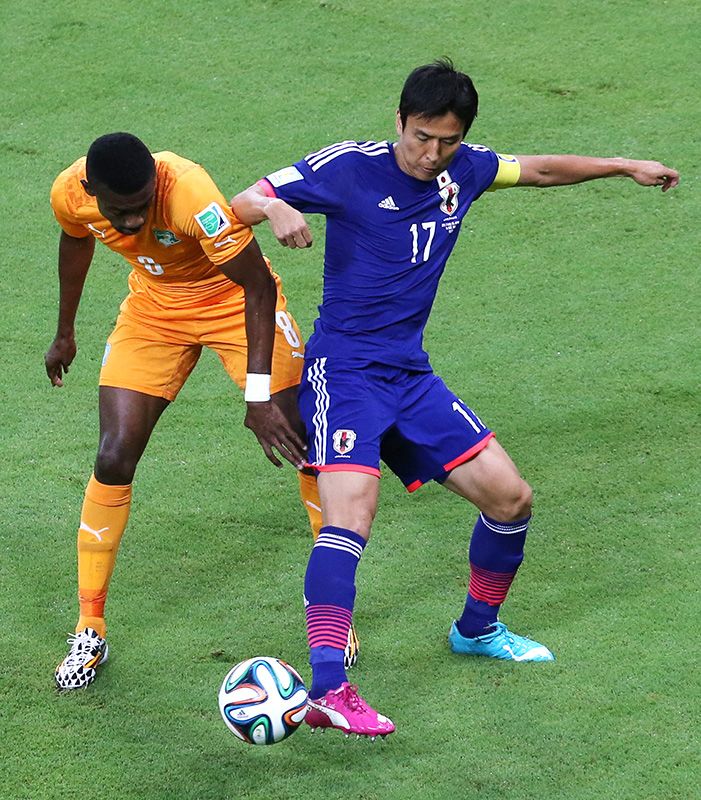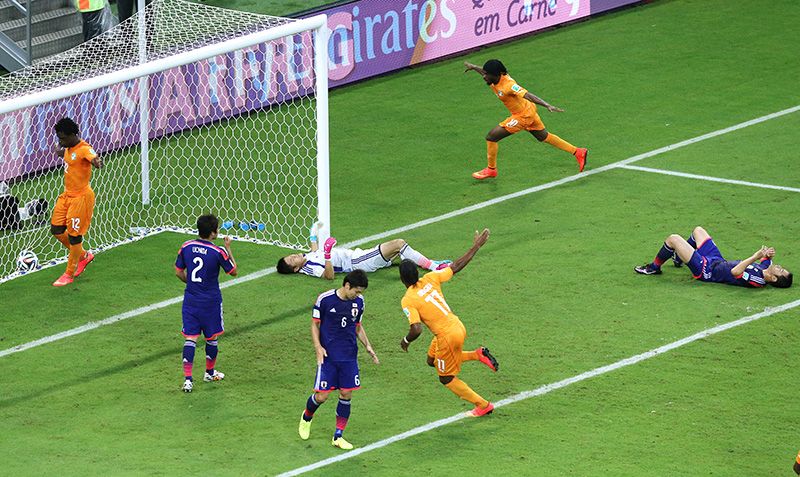
A Loss for Japan, But a Clear Path Forward for Its Soccer
Culture- English
- 日本語
- 简体字
- 繁體字
- Français
- Español
- العربية
- Русский
Japan’s first appearance in the 2014 World Cup kicked off at 10:00 PM on Saturday, June 14—10:00 AM on the following day, Japan time. The game took place in Recife, Brazil, fully halfway around the world from Japan. The distance did not keep some 7,000 Japanese fans from traveling to the match, though. And as they took to the stands at the Arena Pernambuco, their numbers seemed even greater.
A Home-Stadium Mood for Team Japan
 Honda Keisuke gives Japan a 1–0 lead in the first half of the Côte d’Ivoire match (© Jiji Press).
Honda Keisuke gives Japan a 1–0 lead in the first half of the Côte d’Ivoire match (© Jiji Press).
The idea that an entire home crowd had been imported to Brazil for the match grew still stronger when the time came to sing “Kimigayo,” the Japanese national anthem. I had never heard the song sung so loudly and clearly anywhere outside of Japan. As the players took the field and prepared to kick off, it truly felt like a home game for Japan.
This year marks the twenty-first since the launch of the J. League professional soccer league in Japan and the sixteenth since Japan first made it to the World Cup finals. The fifth consecutive appearance on the world stage for Samurai Blue began with a group-round match against African powerhouse Côte d’Ivoire. At the helm for the Japanese side was the Italian Alberto Zaccheroni, in his fourth year managing the national squad.
The starting members included some well-known faces: captain Hasebe Makoto (FC Nürnberg), Honda Keisuke (AC Milan), Kagawa Shinji (Manchester United), Nagatomo Yūto (Inter Milan), and Okazaki Shinji (FSV Mainz 05). These players, with their international league experience, have formed the core of “Zack Japan,” as the Zaccheroni-led team is known, for some years. There were worries that Hasebe would not recover from a recent injury in time for the game, but there he was.
The starters for Côte d’Ivoire, meanwhile, included Gnégnéri Yaya Touré (Manchester City), selected as the Confederation of African Football’s African Footballer of the Year for three consecutive years from 2011 to 2013, and the rising talent Gervinho (Roma). Surprisingly, the team’s captain and all-time top scorer Didier Drogba (Galatasaray SK) started the match on the bench.
Establishing a Japanese Brand of the Game
One of the key aims for Samurai Blue in this tournament is to firmly establish a unique Japanese style of play that the team can build on into the future. As Okazaki, who put up 15 goals in the German Bundesliga this season, described it before the World Cup began: “In the four years since 2010 we’ve seen plenty of Japanese players step forward and make their mark in leagues around the world. I think international fans of the sport are becoming aware of what we can do on the pitch.”
The players Okazaki refers to no doubt include Kagawa, who played for the Borussia Dortmund team that won the 2011–12 Bundesliga championship before heading to Manchester United in the English Premier League. Nagatomo is now a key player for Inter in the Italian Serie A, while Honda has the honor of wearing the number 10 jersey for Milan. And Okazaki himself tied for seventh in the 2013–14 Bundesliga goal rankings. On an individual level, there are clearly Japanese players who have staked out impressive territory in the game, as Okazaki says.
Soccer is not a game played by individual stars, though. At the team level, how do the Samurai stack up? Okazaki admits: “When we play as a national team, we don’t earn so much praise.”
Kagawa is quick to agree: “Nobody has any idea what ‘Japanese soccer’ is supposed to be.” And other team members, like Hasebe, Uchida Atsuto (Schalke 04), and Sakai Hiroki (Hannover), note that they feel their teammates in Europe look down on Japanese soccer.
Building a Future for the Japanese Game
The reason for this is simple: Japan, which has a relatively short history of high-level league play, has yet to establish a style that could be called uniquely Japanese. The English game features what could be called a “fighting style,” with plenty of physicality and body contact. Ask about German soccer, and you get explanations touching on the work ethic and dogged determination seen on the pitch. The French game has not been so visible internationally in recent years, but France is still described in terms of its “champagne soccer,” a beautiful, extravagant passing game. Spain has its brisk, short passes to connect the play, Brazil its brilliantly lively teamwork among players with immense individual talent, and Argentina its mixture of individual flair and rough-and-ready grinding on the field.
 Captain Hasebe Makoto came off a recent injury to appear in Japan’s World Cup opener (© Jiji Press).
Captain Hasebe Makoto came off a recent injury to appear in Japan’s World Cup opener (© Jiji Press).
Now Japan wants to put its own stamp on the sport. As Hasebe put it before the tournament started: “For the last four years we’ve been in pursuit of a Japanese soccer style. A way for us to win matches in international competition while feeling pride in our own unique approach to the sport. In this World Cup, I hope to build this sort of future for Japanese soccer.”
During the last four years the blueprint for this has come into shape. The Japanese game is built with players who are small but agile. Everyone on the team is a hard worker with great stamina. As a team, they display great regularity and chip away at their opponents with multiplayer attacks. Now, at the Brazil 2014 tournament, Zack Japan hopes to put this style of soccer on display before a global audience.
Don’t Back Down in Defeat
Despite these ambitions going into the World Cup, on June 14 the Japanese team went down in a 2–1 defeat to les Éléphants of Côte d’Ivoire. Japan scored first, 16 minutes into the game, when Honda neatly trapped an assist from Nagatomo and drove it home with a powerful left-footed strike. But this would be the team’s only bright moment. Throughout the game Samurai Blue played timidly in the face of their African opponents, and when Drogba finally came on 15 minutes into the second half, the Japanese players appeared to fear the Ivorian hero to such a degree that they failed to mark the other threats on the field.
 A dejected Japanese defense watches Côte d’Ivoire celebrate its second goal on June 14 (© Jiji Press).
A dejected Japanese defense watches Côte d’Ivoire celebrate its second goal on June 14 (© Jiji Press).
In the second half Côte d’Ivoire capitalized on this situation with a pair of goals just two minutes apart, with Yaya Touré and Gervinho each heading a cross into Japan’s net. Japan’s defeat was total, both in its man-to-man matchups with the Ivorians and in terms of its overall strategy.
With this defeat under their belt, the Japanese now must begin their preparations for the June 19 match against Greece by deciding whether to alter this strategy. Some soccer analysts noted that as Japan’s stated desire to play an attacking game has not panned out, it might be time to return to a more grounded, defensive approach. This is the choice that faces a wavering Zaccheroni right now.
If this World Cup is the stage for Japan to launch its soccer of the future, though, it makes little sense to shift strategy so drastically now. Even a Japanese team that ekes out victories with a defense-minded game would be one that shows no evolution from the past.
The World Cup is a tournament where national teams must inspire and invigorate younger generations of players. Zack Japan has come this far; while some adjustments are of course needed, it will be important to continue onward with the same style that has served the team until now.
We should remember that it was this very inspiration—this hope for the future—that brought so many thousands of Japan supporters halfway around the world to cheer Samurai Blue on. To fall back on defense now would mean to walk away from those fans’ hopes. The way forward for Japan lies on the other half of the field.
(Originally written in Japanese on June 16, 2014. Banner photo: Japan manager Alberto Zaccheroni grimaces after the team’s opening loss to Côte d’Ivoire. Photo courtesy Jiji Press.)
Soccer football World Cup sports Brazil Zaccheroni Cote d’Ivoire Samurai Blue